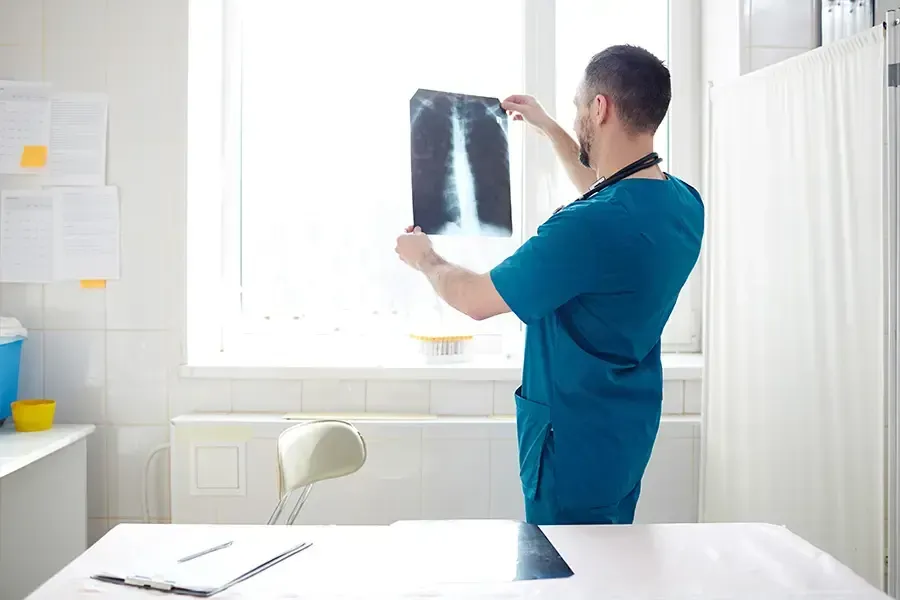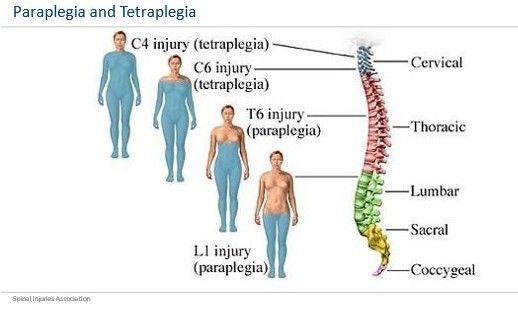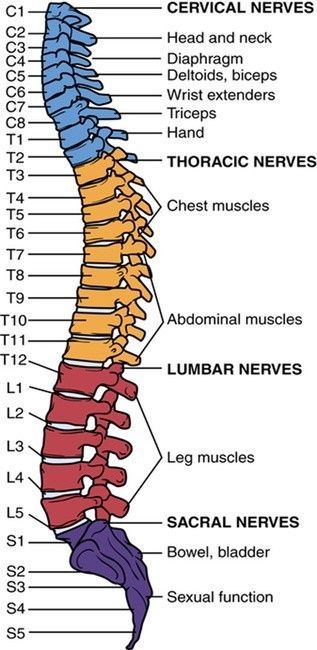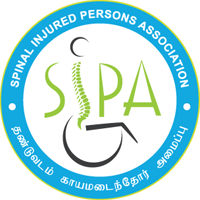Spinal Cord Injury
What is spinal cord?
The spinal cord is a long, thin, tubular bundle of nerves that extends from the base of the brain down through the spinal column. It serves as a vital part of the central nervous system (CNS), along with the brain. The spinal cord is protected by the vertebrae.
The primary function of the spinal cord is to relay information between the brain and the rest of the body. It serves as a pathway for sensory information traveling from the body to the brain (such as sensations of touch, pain, and temperature) and for motor commands traveling from the brain to the muscles and organs, enabling voluntary movement and involuntary processes like reflexes.
The spinal cord consists of nerve tissue containing bundles of nerve fibers, including both sensory neurons (which carry sensory information to the brain) and motor neurons (which transmit signals from the brain to muscles and glands). It also contains supporting cells called glial cells, which provide structural support and insulation for the neurons.
Overall, the spinal cord plays a crucial role in coordinating and regulating various bodily functions, including movement, sensation, and reflexes. Damage to the spinal cord, such as that caused by injury or disease, can lead to significant impairment of these functions and may result in paralysis, loss of sensation, and other neurological deficits.


Figure 1.
What is spinal cord injury (SCI)?
A spinal cord injury (SCI) is damage to the spinal cord that results in a loss of function, such as mobility or feeling. The severity of the injury depends on where the spinal cord is damaged and the extent of the damage. SCI can result from trauma, such as a car accident or fall, or from disease or degeneration of the spinal cord. Common causes of SCI include motor vehicle accidents, falls, acts of violence, and sports injuries.
SCI can lead to a range of symptoms, including paralysis, loss of sensation, muscle weakness or spasms, and problems with bowel or bladder control. The effects of SCI can be temporary or permanent, depending on the extent of the injury and the effectiveness of treatment.
Treatment for SCI typically involves stabilizing the spine to prevent further damage, controlling symptoms, and rehabilitation to maximize function and independence. This may include physical therapy, occupational therapy, assistive devices, and medications. In some cases, surgery may be necessary to repair damage to the spine or relieve pressure on the spinal cord. Despite advances in treatment, SCI often results in significant long-term disability.
How will spinal cord injury affect the body? (See figure 1)

Figure 2.

As for levels, injuries are classified based on the affected segment of the spinal cord:
Cervical (neck) region: Higher on the spinal cord, affecting the neck and potentially leading to quadriplegia.
Thoracic (upper back) region: Affects the chest and upper body, potentially causing paraplegia.
Lumbar (lower back) and sacral (pelvic) region: Can result in paraplegia, impacting the lower limbs and lower body functions.
Each case is unique, and the impact of a spinal cord injury varies depending on the specific location and severity of the damage.
For instance, the nerve roots in your neck are called cervical nerves and are numbered 1- 8 in descending order. There are 12 thoracic nerve roots, 5 lumbar and 5 sacral nerve roots. These nerve roots branch out and are responsible for controlling muscles, sensations and organs in different parts of the body (see figure 2).
A spinal cord injury (SCI) can have profound effects on the body, depending on the severity and location of the injury. Here are some common ways SCI can affect the body:
Paralysis: SCI often leads to partial or complete paralysis below the level of the injury. This means that depending on where the spinal cord is damaged, individuals may lose movement and sensation in their legs (paraplegia) or in both their arms and legs (tetraplegia or quadriplegia).
Loss of sensation: Damage to the spinal cord can result in a loss of sensation below the level of injury. This means individuals may not be able to feel touch, temperature, or pain in the affected areas.
Changes in bowel and bladder function: SCI can disrupt the normal functioning of the bowel and bladder, leading to problems with control and emptying. This can result in urinary or fecal incontinence, as well as increased risk of urinary tract infections and constipation.
Muscle spasms and weakness: SCI can cause muscle spasms or stiffness (spasticity) in the affected muscles. Additionally, muscles may weaken due to lack of use or nerve damage.
Respiratory problems: Depending on the level and severity of the injury, SCI can affect breathing muscles and respiratory function, leading to difficulties with breathing and increased risk of respiratory infections.
Sexual dysfunction: SCI can impact sexual function and fertility in both men and women. Changes in sensation, muscle function, and hormone levels may affect sexual desire, arousal, and reproductive function.
Blood pressure and circulation: SCI can affect blood pressure regulation and circulation, leading to issues such as orthostatic hypotension (a drop in blood pressure when changing positions), blood clots, and skin breakdown.
Secondary health complications: Individuals with SCI are at increased risk of developing secondary health complications, such as pressure ulcers (bedsores), muscle contractures, osteoporosis, and autonomic dysreflexia (a potentially life-threatening condition characterized by a sudden increase in blood pressure).
Overall, SCI can significantly impact multiple aspects of a person's life, including mobility, independence, and overall quality of life. Management and treatment often involve a multidisciplinary approach to address the complex physical, functional, and psychosocial needs of individuals with SCI.
What is complete and incomplete SCI?
Complete" and "incomplete" SCI refer to different levels of severity of a spinal cord injury (SCI). SCI can cause a wide range of symptoms and impairments depending on the location and severity of the injury.
Complete SCI: This means that there is a total loss of sensation and motor function below the level of the injury. In other words, the individual has no voluntary movement or sensation in the areas of the body controlled by nerves below the site of the injury. This typically occurs when the spinal cord is completely severed or significantly damaged, resulting in a complete loss of function.
Incomplete SCI: In contrast, incomplete SCI means that there is some remaining sensation or motor function below the level of the injury. The extent of function that remains can vary widely depending on the specific location and severity of the injury. Incomplete SCI might result in partial paralysis, loss of sensation, or other impairments, but there is still some degree of function or sensation retained.
These terms are important for medical professionals to communicate the severity of the injury and to determine appropriate treatment and rehabilitation strategies for individuals with spinal cord injuries.
Life after spinal cord injury
Life after a spinal cord injury (SCI) can be profoundly different from life before the injury, but with the right support, resources, and mindset, many individuals with SCI are able to lead fulfilling and meaningful lives. Here are some aspects to consider:
Physical Adaptations: Adjusting to physical changes is a significant aspect of life after SCI. This may involve learning to use mobility aids such as wheelchairs, braces, or crutches, as well as adapting living spaces for accessibility. Physical therapy and rehabilitation can help individuals regain strength, mobility, and independence to the extent possible.
Emotional and Psychological Impact: Coping with the emotional and psychological effects of SCI is crucial. It's common for individuals to experience feelings of grief, loss, frustration, and depression after a spinal cord injury. Counseling, support groups, and peer mentorship can provide valuable emotional support and help individuals navigate the adjustment process.
Social Support: Building a strong support network of family, friends, caregivers, and healthcare professionals is essential. Having people who understand and empathize with the challenges of SCI can provide encouragement, assistance, and companionship.
Recreation and Leisure Activities: Engaging in recreational and leisure activities can enhance quality of life and provide opportunities for socialization, enjoyment, and personal fulfillment. Adaptive sports, hobbies, arts, and cultural activities tailored to individual interests and abilities can be pursued with creativity and adaptation.
Education and Employment: Pursuing education and employment opportunities is possible after SCI with the right accommodations and support. Vocational training, job coaching, and assistive technology can help individuals achieve their educational and career goals.
Advocacy and Empowerment: Many individuals with SCI become advocates for themselves and others with disabilities, working to raise awareness, promote accessibility, and advocate for policy changes to improve the lives of people with disabilities.
Health and Wellness: Maintaining overall health and wellness is important for individuals with SCI. This includes managing secondary health conditions, such as pressure ulcers, urinary tract infections, and respiratory issues, through proper medical care, nutrition, exercise, and preventive measures.
Adaptive Technology and Innovation: Advances in technology and innovation have led to a wide range of adaptive devices and assistive technologies that can enhance independence and functionality for individuals with SCI. These include mobility aids, communication devices, environmental control systems, and more.
Spiritual and Personal Growth: Exploring spirituality, finding purpose, and pursuing personal growth and fulfillment are important aspects of life after SCI. Many individuals find strength, resilience, and meaning through spiritual practices, hobbies, creative pursuits, and personal development.
While living with SCI presents unique challenges, it's important to focus on abilities rather than limitations and to seek out opportunities for growth, connection, and fulfillment. With resilience, determination, and support, individuals with SCI can lead rich and meaningful lives.


